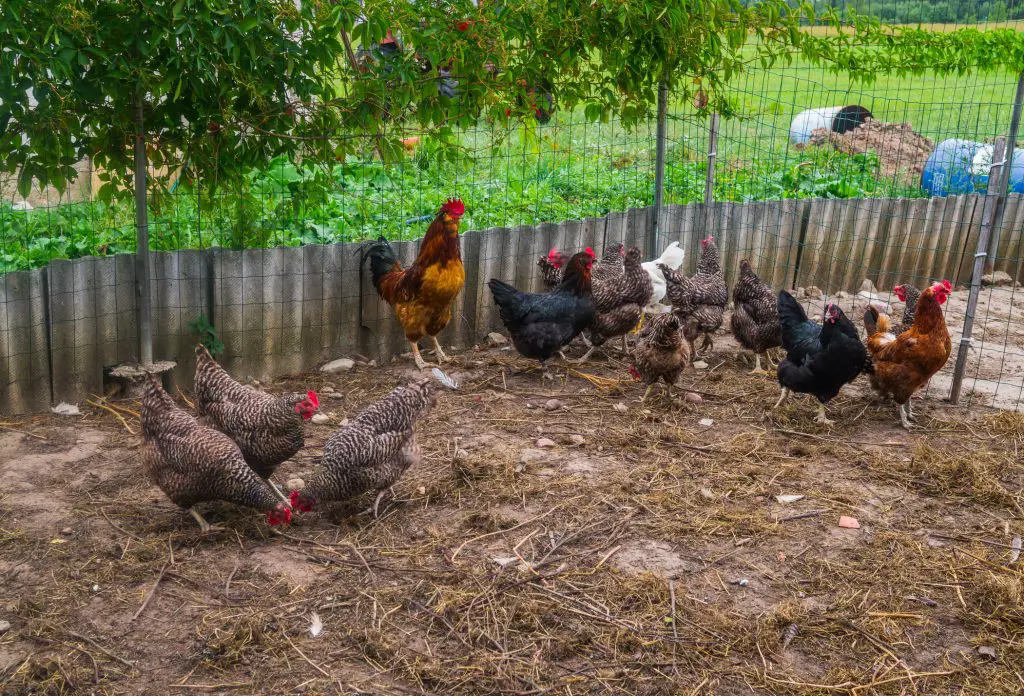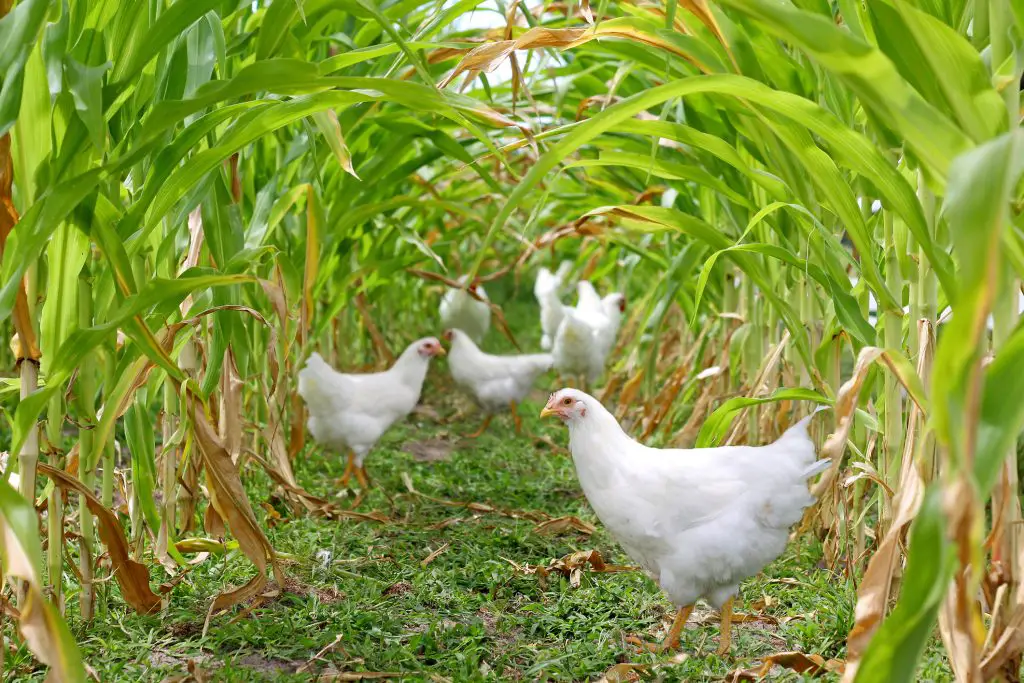This post contains affiliate links.
Backyard chickens have become very popular. But many people who would like to start raising chickens, whether for eggs or meat, are concerned they don’t have enough property to keep chickens. Chickens raised for eggs have different space requirements than chickens raised for meat.
The amount of land needed to raise chickens for eggs is 20.5 square feet per chicken. If raising chickens for meat, the property needed increases to 28.5 square feet per chicken. This includes nesting, roosting and roaming space. These are minimum amounts to prevent overcrowding.
The size of the property needed to raise chickens is affected by the reason why the chickens are being raised, i.e. eggs or meat, and if you have other agricultural activities on your land. If you are just starting out and want to know how many chickens you should get read my article, How Many Chickens Should A Beginner Have?

Property Size Based On The Reasons For Raising Chickens
Chickens are raised for two main reasons: eggs and meat. The amount of property needed will be different based on the reason for keeping them, as it directly impacts the amount of land required to raise them successfully.
Space Requirements For Egg Laying Chickens
The property size requirement for egg-laying chickens is slightly different from that of raising chickens for their meat; this is because egg-laying chickens need extra space in the chicken coop, but they do not need as much roaming space. There will be only hens in this case.
Not all the egg-laying chickens will be outside at one given time because some of them will be sitting on their eggs most of the day, which means that the outside roaming space needed will be less even though the nesting box area size will be more. 15 Square feet of roaming space per bird is sufficient for raising chickens for producing eggs.
The recommended space for egg-laying chickens inside the coop is 5 square feet per bird. It means that if you have 10 hens for laying eggs, you will need 50 square feet of space for nesting in the coop. The spacing of nesting boxes will depend on the type of boxes acquired.
The size requirements inside the coop include nesting areas where the hens have access to nesting boxes as well as spaces to sleep and rest, this is called the roosting place, the sheltered area for egg-laying chickens is a lot more than chickens raised for meat because all the chickens are hens, so they need more space for nesting. The total space needed for 10 hens will be 205 square feet or the space of a one-car garage.
Here is what the property sizing table looks like for egg-laying chickens:
| Quantity | Nesting space | Roost space | Roam space | Total space |
| 1 chicken | 5 sq feet/bird | ½ sq feet/bird | 15 sq feet/bird | 20.5 sq feet |
| 10 chickens | 50 sq feet | 5 sq feet | 150 sq feet | 205 sq feet |
| 50 chickens | 250 sq feet | 25 sq feet | 750 sq feet | 1025 sq feet |
| 100 chickens | 500 sq feet | 50 sq feet/bird | 1500 sq feet | 2050 sq feet |
- Designed to Last: Made from galvanized steel creating a durable and stable structure.
- Chicken Accommodations: Designed to fit medium to large hens comfortably. Each compartment...
- Optimal Egg Laying Environment: Comfortable compartments provide a private, safe and...
Egg-laying chickens have different nutritional requirements than meat chickens. Learn how to provide the right amount of calcium to your egg-laying chickens in my article, Oyster Shells, Eggs Shells and Chickens The Complete Guide.
Space Requirements When Raising Chickens For Meat
The property size requirements for raising chickens for their meat are different from egg-laying chickens because they need more roaming space as there is a good chance that most of the chickens will be in and out of the coop at the same time.
In this case, roosters and hens are mixed because the chickens are raised for their meat and mating purposes. It will not be sustainable if there are no replacements for the chickens being used for their meat. In some cases, extra coops are set up for the chicks, which also affects the amount of space needed on a property.
The chicks also need to be kept somewhere. They are normally kept indoors until they are completely feathered, and then the chicks are moved into a separate coop until they are big enough to fend for themselves and survive with the other chickens. More on this in the next section.
When raising chickens for their meat, there needs to be more roaming space, and the same amount of space inside the sheltered area as the hens will also lay fertilized eggs. The roosting area is always a necessity in any coop because chickens want to sleep and rest off the ground to stay away from predators.
Meat chickens required 25 square feet of roaming space per chicken, which is about 10 sq feet more than meat birds, or about 66%. But they need less nesting space, only 3 square feet per bird versus 5 square feet.
Here is what the property sizing table looks like for chickens raised for meat:
| Quantity | Nesting space | Roost space | Roam space | Total space |
| 1 chicken | 3 sq feet/bird | ½ sq feet/bird | 25 sq feet/bird | 28.5 sq feet |
| 10 chickens | 30 sq feet | 5 sq feet | 250 sq feet | 285 sq feet |
| 50 chickens | 150 sq feet | 25 sq feet | 1250 sq feet | 1425 sq feet |
| 100 chickens | 300 sq feet | 50 sq feet | 2500 sq feet | 2850 sq feet |
Property Space Requirements For Raising Chicks
When you keep chickens, you will eventually have baby chicks to raise. Chicks have specialized needs that require extra floor space. It is especially true if you are raising chicks to sell or to raise for commercial purposes.
Chicks cannot regulate their body temperature until they are fully feathered. They need a dedicated enclosed area that has proper ventilation, is out of the wind, and is dry and warm.
Chicks at different stages of development need to be separated, so you will need two extra spaces for a brooder house that has unhatched and newly-hatched eggs and space for older chicks to stay safe and warm until they can venture outside on their own.
Here are the space requirements for a chick from 0 – 12 weeks and older. The table will illustrate the flooring (space) needs, food, and watering space needed per chick.
| Age Of Chicks | Floor Space PerChick | Space For Water(per 100 chicks) | Space For Feed(per 100 chicks) |
| 0-4 weeks old | ½ square feet | 2 x 2-gallon waterers = 4 feet | 2 x 3ft feeders = 6 feet |
| 4-8 weeks old | 1 square feet | 2 x 5-gallon waterers = 6 feet | 2 x 5ft feeders = 10 feet |
| 8-12 weeks old | 2 square feet | 2 x 5-gallon waterers = 6 feet | 3 x 5ft feeders = 15 feet |
| 12 weeks and older | 3 square feet | 4 x 5-gallon waterers = 12 feet | 5 x 5ft feeders = 25 feet |
I have several articles dedicated to raising baby chicks, learn more about some of the unique needs of baby chicks in my articles:
- Why Baby Chickens Need Grit (and How to Provide It)
- Do Baby Chickens Need Baths?
- Do Baby Chickens Need Company?
- RentACoop Has a Solution! | Our 16x16" Heating Plate with Foldable Anti-Roost Cone warms...
- We Thought of Everything! | BONUS space-saving Foldable Anti-Roost Cone keeps chicks and...
- Why You'll Love It! | Durable, premium quality components are built to last multiple...
Effect of Other Agricultural Activities on Land Required To Raise Chickens
Whenever keeping chickens, it is important to consider the other agricultural activities on the property; the size of the property might be too small if there are too many other activities going on at the same time. On the other hand, it is great to keep chickens on a farm with other activities.
- Chickens keep insects at bay because they love eating them; this means that the chickens will keep bugs at bay that would normally destroy crops. Insects like locusts can destroy crops in an instant.
- Processed chicken manure makes great fertilizer, so it makes sense to use it in the fields. Some of the dried vegetation also makes for great bedding in the chicken coop, so it is a winning situation both ways.
The size of the property that is used to raise chickens should be considered when other agricultural activities are being conducted because you need to ensure that the chickens have ample space; otherwise, they will pluck their feathers from stress. It is better to give the chickens too much space instead of not enough.

Roaming Space For Commercial/Privately Raised Chickens
The amount of roaming space a chicken needs is important to consider. People tend to give chickens more roaming space when they keep them privately. On the other hand, chickens that are kept for commercial purposes are given less roaming space.
Here is a table to illustrate the amount of roaming space that is needed for chickens raised privately as well as commercially. The number of chickens that need to be raised are also included to make the calculations easier throughout the post:
| Quantity | Roaming space(Private) | Roaming space(Commercial Eggs) | Roaming space(Commercial Meat) |
| 1 chicken | 25 square feet per bird | 15 square feet per bird | 20 square feet per bird |
| 10 chickens | 250 square feet | 150 square feet | 200 square feet |
| 100 chickens | 2500 square feet | 1500 square feet | 2000 square feet |
| 500 chickens | 12500 square feet | 7500 square feet | 10000 square feet |
| 1000 chickens | Not Applicable | 15000 square feet | 20000 square feet |
| 2500 chickens | Not Applicable | 37500 square feet | 50000 square feet |
| 5500 chickens | Not Applicable | 82500 square feet | 110000 square feet |
| 10000 chickens | Not Applicable | 150000 square feet | 200000 square feet |
| To convert from square feet to acres: divide the square feet by 43560 to get the acres for example. 10000 chickens kept commercially will need between 3.4 and 4.6 acres of roaming space. |
This table shows that the quantities of chickens that you will raise will have an impact on the size of the property that will be required to accommodate the chickens. The chance of someone keeping more than 500 chickens privately is highly unlikely.
The reason chickens are raised commercially has an impact on the roaming space and that is why it is between 15 and 20 square feet per bird. It is only the roaming space needed, and it does not include the coops or the run or anything else.
Final Thoughts
The amount of property needed to raise chickens depends on the type of chicken you need to raise, as well as the space that chickens need for nesting, roosting, and moving around. Chickens are kept not only for their eggs but also for their meat. Keeping the environment of chickens clean and sanitary will aid in raising the chickens.
Chickens kept for their eggs have different space requirements than chickens that are kept for meat. Ensuring that your chickens have enough nesting, roosting and roaming space will help keep them happy and healthy.


